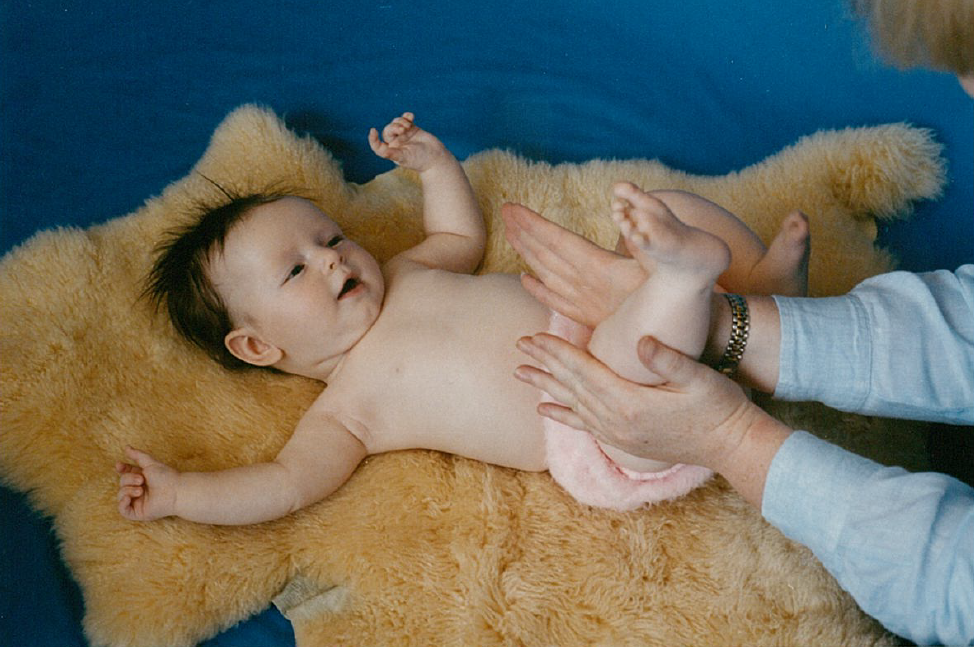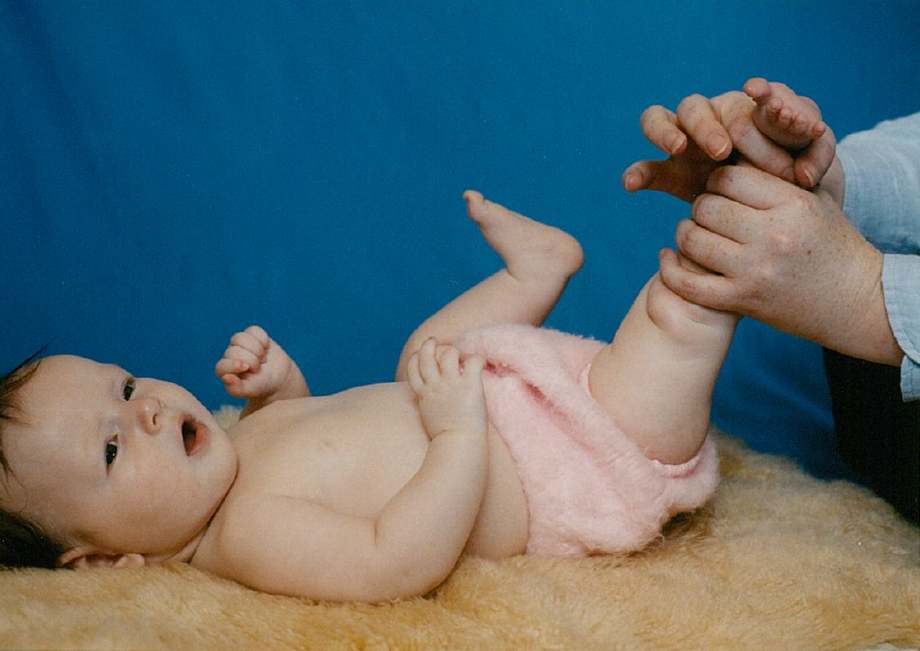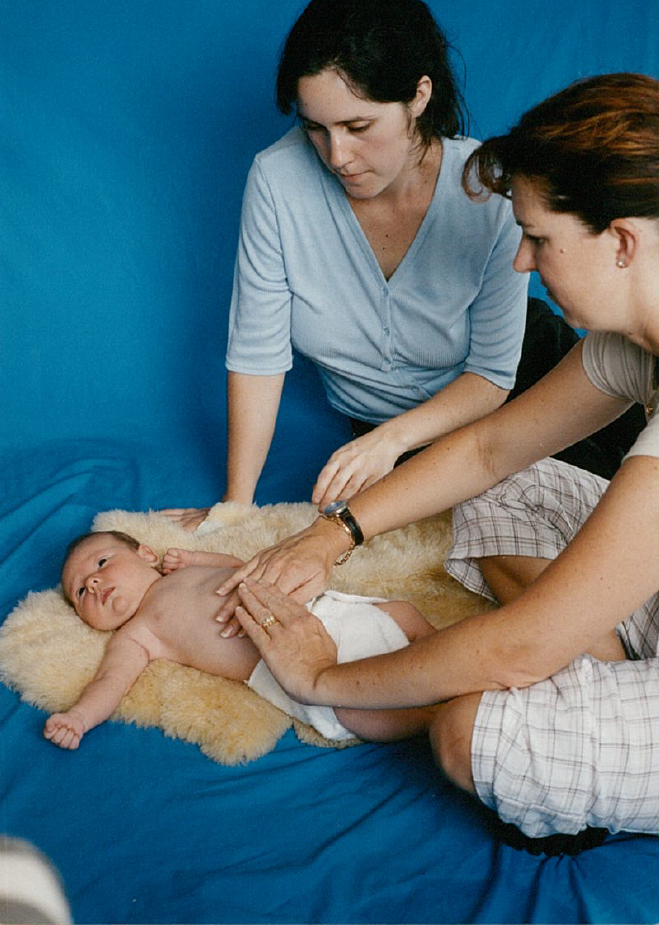Really?
You ask for your baby's permission before massage!
Yes, we know this one sounds strange at first but trust us... this is almost every Infant Massage Instructor's favourite aspect of baby massage. Once you know a little more about it, it may be yours too.
Babies can easily learn to recognise cues. Every parent has seen their baby becomes impatient when Mum sits down and begins to unclip her bra to feed. Bottle fed babies also recognise the signs that a bottle is being prepared and demonstrate the same anticipation, excitement or frustration waiting for their feed to begin.
In these situations, babies demonstrate they can recognise a predictable sequence of events or cues. Infant Massage Instructors use this principal to help you teach your baby a 'permission sequence' for massage. Instructors demonstrate a cue you can use with your baby prior to massage to indicate that massage is going to occur. In no time at all, your baby will learn when you use this cue, it means massage is going to begin.

When your baby learns to recognise a 'permission sequence', they will use body language or vocalisations to communicate whether or not they are happy for massage to take place. They might make eye contact, smile and make some awfully cute and happy noises, they may bounce their arms and legs with excitement or even try to grasp your hands and pull them in so that you can get started with the massage.
Babies take different amounts of time to recognise the cue for massage. An average length of time seems to be 2-8 weeks of daily massage. If you do a little bit of massage every day, you are likely to see specific response cues faster.
Remember, your baby will not recognise this cue immediately. It is something that is recognised over time. An Infant Massage Instructor can make sure you know who to proceed with massage time while your baby is learning to recognise the permission sequence.
It's important you keep watching for cues from your baby during massage time to know when they've had enough. Little ones rarely make it through a full body massage in one sitting; usually preferring small amounts of massage at a time. Regardless of how much massage you get through, be sure to stop when your baby shows they've had enough. This helps them learn how to 'say no' at times they don't feel like having a massage.
The importance of asking permission
Asking permission will help you determine if it is a good time to give your baby a massage. For example, if you perform a permission sequence and your baby is purposefully avoiding eye contact, this can indicate it is not a good idea to massage, (or a good time to provide your baby with any additional stimulation).
Eye contact stimulates a release of hormones in your baby's brain, namely oxytocin. This stimulation and release of hormones excites your baby and their breathing and heart rate will increase. By purposefully avoiding eye contact, your baby could be trying to prevent themselves from becoming overstimulated. Overstimulation occurs when a baby is swamped by more experiences, sensations, noise and activity than they can cope with. If your baby is showing they cannot cope with the stimulation of eye contact, it will not be a good time to provide additional stimulation through massage.

Most adults think of massage as a relaxing experience but for babies, massage is both relaxing and stimulating. When you give your baby a massage, you're actually stimulating their central nervous system. Because massage is stimulating, it should only be provided at times your baby can cope with additional stimulation (e.g. when waking from a nap as opposed to before going to sleep).
Besides helping you figure out if you've found the right time for massage, performing a permission sequence will help you teach your child about appropriate touch from infancy.
Children learn best through repetition of practical, multi-sensory experiences. Waiting until a child is in preschool or primary school, sitting them down and having a discussion about appropriate touch and what action is expected of them if someone does touch them inappropriately, is perhaps not the most effective way to ensure your child will run, shout and scream 'no', or attempt to otherwise defend themselves.
How can we possibly expect children to react this way to inappropriate touch when every practical experience they have had with adults teaches them the opposite?
Many children are conditioned and taught to respect adults; to do as they're told, not to hit, kick, scream or fight. These are all important lessons to learn of course. In learning these things however, children are provided with a very clear message, being - it is not OK to say no to an adult. Consider that message for a moment. In a child's daily life, how many situations can you think of where it is acceptable for a child to say no to an adult when given an instruction?
How can we possibly expect children to respond in a different way to a stressful and intimidating situation? When under stress, people tend to react using learned and practised behaviours.
When using a permission sequence, your are showing your baby that you would like to massage. By pausing and allowing your baby to respond, you are helping your child learn that when a person wants to have contact with them, they must have permission first. In addition to this, from an early age, your child has the benefit of a repeated practical experience where they are allowed to say no to physical contact.
This process shows your child that when it comes to touch it is perfectly acceptable to say no to an adult. By responding appropriately to 'no cues' (by not commencing massage) you can help your child learn by experience that when they refuse physical contact, their decision is respected.

If you would like to learn more about recognising cues your baby might give during massage time or how to perform a permission sequence for massage, contact a qualified Infant Massage Instructor. Instructors offer one-on-one private appointments or hold
baby massage classes where multiple parents are taught how to massage simultaneously.
To locate a qualified instructor, contact the
Infant Massage Information Service and provide your post code. You will then receive an email with instructor details for your local area.
If you are interested in training in baby massage and becoming a
Certified Infant Massage Instructor, details can be found via the following links:
Certificate in Infant Massage Instruction
Becoming a Paediatric Massage Consultant
3-day intensive programs or correspondence study
Units of study (course content)
Enrolment fees
Training dates and locations